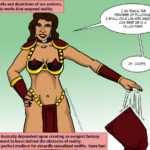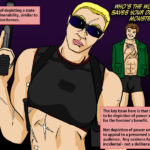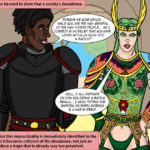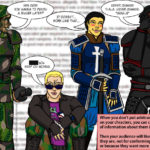Alternative approaches to female characters
(The promised follow up to this post)
Firstly, if the Internet has taught us anything it’s that if you make a character who is compelling and interesting – some portion of your audience will have very sexy thoughts about them.
However, since there is the ongoing pressure feel to make female characters especially sexy – here’s a few tips for those who are conflicted on writing their female characters – especially warriors.
Consider other means of expression.
A character who’s not interested in getting amorous attention has no real reason to dress up in a sexualized outfit. However a flirtatious character can end up with many reasons to wear unsexy clothing – that doesn’t mean they can’t flirt though.
How a character talks, what they talk about and how they interact with different characters can convey a lot even if their outfit isn’t sexy. And of course, there’s how they decorate their gear and their space.
Example: Jagged Alliance and Jagged Alliance 2, where there were three types of bodies on the battlefield (big male, regular male, female) but all kinds of personalities conveyed through their portraits, dossiers and conversation in game.
Cynthia “Fox” Guzman’s models wears the exact same style of pants and t-shirt as everyone else, but when her moral is high she flirts shamelessly and speaks frequently in multiple entendres and a centrefold photoshoot mentioned in one of her profiles. She’s brazenly sexual from the moment you discover her – and this is the most you’ll ever see of her:
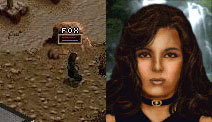
Does she even need to titillate the audience?
As part of the general pressure put on a women in society – there kind of an additional pressure many creators feel – that in order to be liked a female protagonist needs to look sexy, talk sexy, go to sexy places, have a sexy love interest, have a sexy shower scene, have a sexy sex scene.
However when actually step back and look at it – almost none of this really necessary or often even helpful. It just wastes the audiences time and shows them the same things they saw every other time. Breaking away from it can provide a great breath of fresh air.
Example (with spoiler ahead): Marge Gunderson in Fargo (1996) is a middle aged police woman who is seven months pregnant. Marge has a very distinct (and very not glamorous) small town accent, a bald husband and a need to cover up constantly due to the winter cold. She never goes to a strip bar, never talks about her sex life and never looks for affection outside of her marriage – but she does investigate a crime and make the big arrest at the end. Then she goes home.
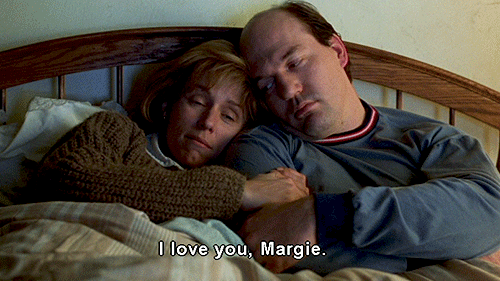
Did Fargo suffer due to this lack of sexy sexiness? NOPE! Fargo was nominated for numerous awards (Frances McDormand won the Oscar for Best Actress for her portrayal of Marge), had fantastic box office returns and the Coen Brothers are now doing a Fargo TV series.
How many outfits do they have?
Do their “work clothes” or signature outfit need to be how they express their sexuality? What if they protect themselves meticulously while when expecting a fight, but have a passion for revealing fashions when they’re off duty? What if they wear boring street clothes but like to show off when they dress up for fancy parties? What if you meet her in a nighclub wearing a silly little black dress, then the next time she’s in full body armor?
You can use other moments to build up a character and make them complex and interesting (and sexy), you can’t prioritize sexiness over practicality in their attire and then try to erase it later with other explanations or special circumstances.
Example: Aveline de Grandpré in Assassin’s Creed: Liberation has a cleavage flaunting dress for when she presents herself as the noblewoman she is, a very unflattering set of ragged clothes for when she disguises herself as a slave and a rather badass outfit for when she gets down to business as an assassin.
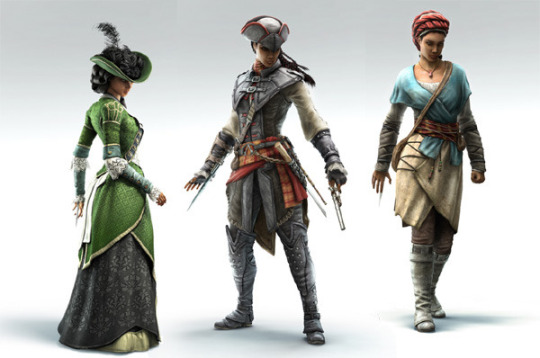
People react differently to Aveline depending on how she is dressed, and she has access to different abilities and tricks. A change of clothes can really mean a massive change in perception, provided the change is meaningful. Samus Aran’s sexy outfits for her pinups did not, in any way, justify her wearing her boyshorts and tank top onto a battlefield… especially not with those ugly heels and a gun.
– wincenworks
(duskwitch also directed us to this fine article with some pointers of some ingrained design principles which have senselessly limited female character design)
Destroyable Armor – Why we should destroy it
I was quite surprised to find people rushing to comment that a certain terrible screenshot was actually demonstrating destroyable armor (I guess if you already knew about it, and hence knew that her armor had been destroyed… so it doesn’t really help with marketing).
Now we have mentioned destroyable armor before… but maybe it’s best we do a little more talking on it since apparently it’s a thing that’s been sold as making sense. Surprisingly, the first appearance of this trope in video games (that I’m aware of) was inflicted up a male character.

A manly man named Arthur who was on a quest to save his love, Prince Prin Prin (actual name!), from a foe no less than Satan himself (who lives in Hades… just go with it! I promise nothing in the game will make any more sense than this summary. Nothing at all.)
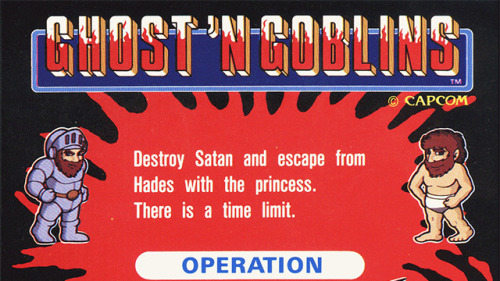
It was released in 1985 and is probably one of the most frustrating video games ever to grace an arcade (you can play it here if you don’t believe me, and imagine putting money in every time you run out of lives)
Arthur had a full suit of plate male armor that would, upon the impact of any attack or even light touch of an enemy, fly off and leave him running around in his whitey tighties (later re-inventions would give him boxer shorts). Destroyable armor didn’t make sense in Ghosts ‘N Goblins and it’s not going to make sense anywhere else.
While “soft” armors like kevlar weave and leather will become less protective over time they don’t fly apart for a very simple reason. Anything that hits your hard enough to dislodge armor from your person has hit you hard enough to kill you. Even the force to dislodge regular clothes by impact (rather than deliberate tearing off) will easily kill you in a most spectacular fashion!

Armor isn’t a car, it doesn’t have crumple zones. Your armor being blasted off you and you coming out relatively unscathed means that you are literally tougher and more resistant to damage of all sorts than your armor is.
That’s the story you tell when you show a character get hit and their armor falls off. It doesn’t matter if it applies to all genders (though it always seems to be women chosen for the “demo”), it just doesn’t make sense and is more distracting than simply going without armor. There are so many better ways to convey damaged armor:
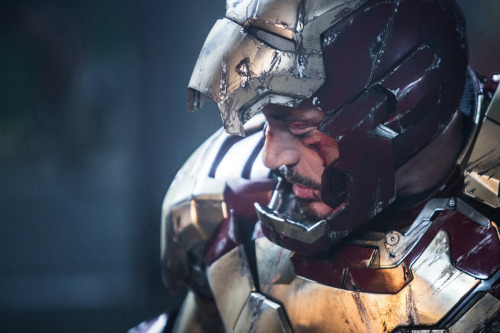
Missing enamel/coloring, destroyed ornamentation, blood marks, changes in the silhouette on parts etc all convey that the armor is damaged and becoming less and less useful without also conveying that the actual point of the game is to try to see your character naked without them dying.
– wincenworks
Starfire, solar-powered skin and why (sexual) context may or may not matter
So the arguments suggesting that skimpy female warrior outfits make sense in the context of a character have been around almost as long as the outfits themselves… Not surprisingly, usually the reasoning behind the costume seems to get invented after the costume is already established.
Today I decided to take a look at one of characters famous for supposedly having a ‘reason’ to be half-naked on not one, but at least two levels – Starfire.
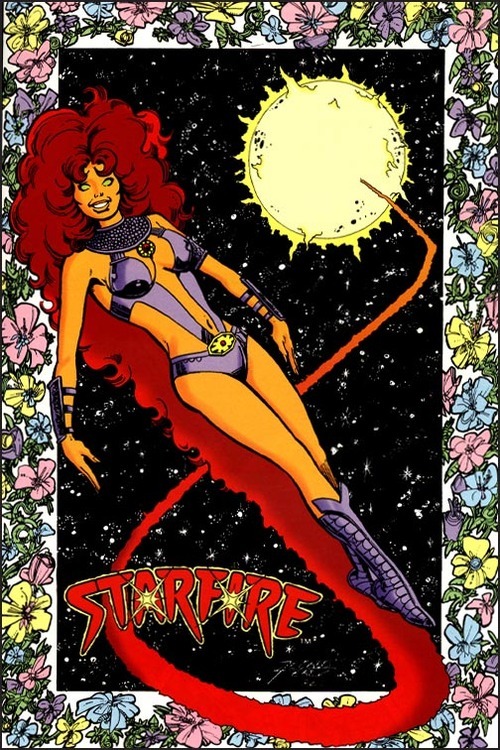
The costume(s):
First let’s look at her costume out of context… The original one looks pretty awful, right? Impractically skimpy and, depending on the artist, the torso part ranges from somehow plausible (with a help of double-sided tape, at least), to outright damn impossible.
Still, reflective of what superheroes looked like back in the 80s. It’s not like her male colleagues didn’t have their share of silly-by-today’s-standards costumes.
Needless to say, a character that’s been around since 1980 had a few at least minor costume changes and redesigns throughout years, including the (much beloved) child-friendly version from the 2003 cartoon.
Then… the New 52 ’s turn came.
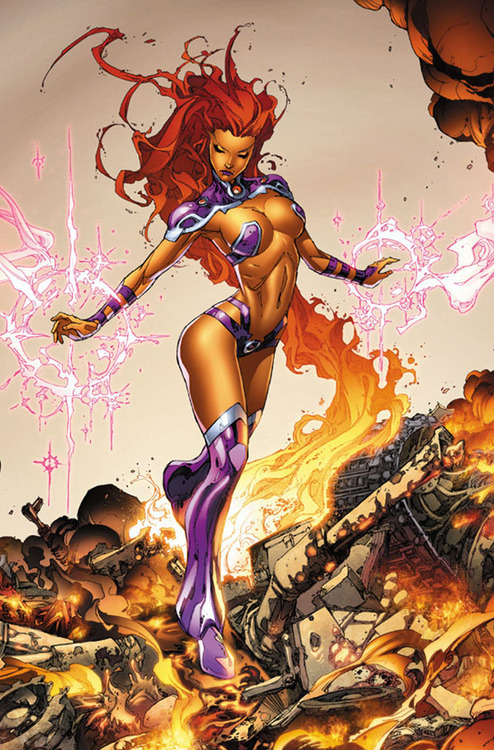
Uh… Ah… Um… Bingo?
Don’t get me wrong, I’m quite sure the old version would also score some major bingo points, but this is just beyond any possible level of defying physics and common sense. BABD has nothing but utter respect for the cosplayers that somehow make this costume actually work (especially the nipple-pieces).
Oh, and the way she was written upon her first appearance after the DC reboot (the infamous Red Hood & the Outlaws #1) does not help the case. AT ALL.
Which brings us to…
The “context”
As mentioned earlier, Star supposedly has good reasons to dress the way she does. There may be more, but the two most frequently brought up are:
- Her alien powers are fueled by exposure to sunlight
- Big part of her character is having an agency over her sexuality
We poked the first one a few times already, so let’s get it out of the way quick: SAME FOR SUPERMAN. And if I’m not mistaken, unlike Supes, Starfire is not 100% invincible on top of her strength.
I challenge anyone to find us canon evidence that Kryptonians somehow don’t have to be half-naked to absorb sunlight through skin, but Tamaraneans do. Bonus points if you prove that it’s so totally not because the major character from Krypton is a man, while the major character from Tamaran is a woman.
The second one is a ride, as I have a very basic familiarity with the old Titans comics, let alone post-reboot ones, but fortunately I’m not the first person to talk about the subject of Kory’s depiction, so I had some broader frame of reference. I’ll link the sources in the last section of this post.
Let’s start with the basics: skimpy clothes and sexual liberation are not mutually inclusive. In case anyone forgot, it’s all an arbitrary standard that the Western culture made us assume to be “natural”.
Sadly, yes, I did feel the need to spell this out, as apparently some parties consider it a slight against all women’s sexuality if Star so much as covers her skin with spandex bodypaint.
That said, even if we agree that the revealing costume is expression of Kory being in charge of how sexual she is, the post-reboot comics failed spectacularly at conveying it in a sensible way the old comics did.
The batshit redesign, the art that contorts her spine and shoves her boobs and butt in every scene possible, the writing that turned her basically into a living sex doll (an idea so bad that it got subsequently retconned); all of those things were carefully crafted NOT to put some interesting spin on the established character, but to suit the tastes of DC’s supposed target audience: unimaginative, perpetually horny straight boys.
There’s nothing wrong about Starfire being sexy and openly sexual.
But how does one turn a character like this:
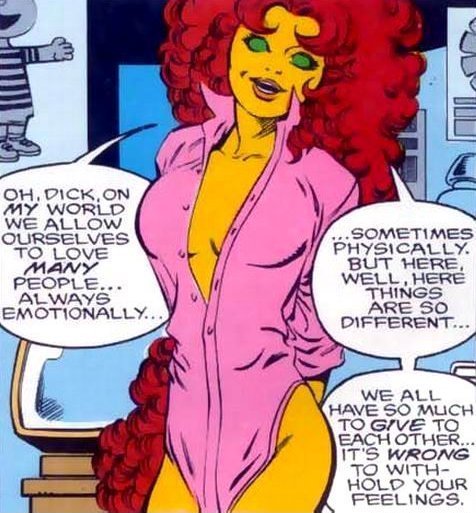
Into someone who joylessly asks people she barely likes for a hookup out of boredom?:
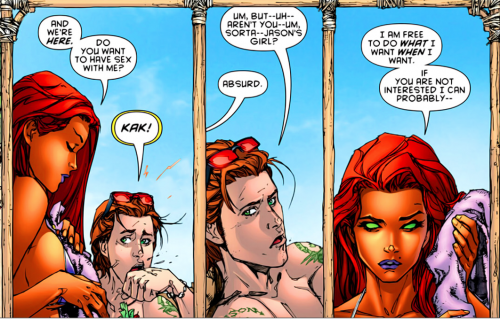
And again, why would any of the above mean she, a superpowered alien warrior princess, should fight crime and villainy in “clothes” that are the superhero equivalent of Scarlet Blade armor? How is her sex life the “context” for her superhero looks?
With the old costume at least it can be argued she’s showing off her body, which she’s very comfortable with (canon in comics), with the new one… she only gets cold in her shoulders and feet? And alien fashion defies physics? IDK
Shortpacked! (itswalky) sums up the problem with New 52 depiction of this character (and DC’s bizarre confidence in it) perfectly in this comic strip (rebloggable version here).
Now, to clear you minds, I recommend you guys to check out theliberationofmanfire, a blog dedicated to showing us what Starfire and other comic superheroines would be like if they were redone as equally scantily-clad and sexualized male characters (and yes, that tumblr does precede thehawkeyeinitiative).
Further on the matter:
- Linkara’s (@atopfourthwall) video review of Red Hood and the Outlaws #1 – for those who don’t want to be directly subjected the awfulness of that comic (skip to 27th minute if you want to hear only the comments regarding the sexualization controversy)
- An example of how well-handled Kory’s sexual agency was in the old comics (Gohtam Central) – worth reading for luanna255’s and juvjuvychan’s commentary.
- The Big Sexy Problem with Superheroines and Their ‘Liberated Sexuality’ – Comics Alliance article that explores mishandling of female sexuality in recent superhero comics.
- YOU’LL COME WHEN YOU SEE THE MANGOS ON THIS RED HOOD AND THE OUTLAWS COVER – The Outhousers article that points out how 32 issues in, Red Hood and the Outlaws is still the kind of comic everyone should be ashamed of reading.
- Reactions Shortpacked! received for making the Starfire strip – apparently (according to enraged dudebros) “has sex with people” is everything about her personality.
- How the infamous Red Hood and the Outlaws #1 sex proposal scene SHOULD have been written – fanmade redo of the dialogue in that comic. Obviously done by people who know Kory’s character as more than just “has sex with people.”
- A response to the ‘Starfire’s covering skin-tight spacesuit is anti-feminist’ confession that comments on the false definition of “empowerment” of sexified female character by agentfiftyseven
- To Pants or Not to Pants – The Superhero Uniform and its Discontents – Dan Roth’s (pointlessarguments101) Chez Apocalypse article (that I quoted before) which examines how fully covering superheroine costumes are not yet a sign of sexism being over in comics
~Ozzie
PS: Funny that Starfire’s official bio seems to not have been updated with anything since the start of New 52 in 2011.
Probably because of neglect, but I like to think that official Teen Titans site just prefers to ignore post-reboot Starfire’s design and personality.
edit: Updated link to Linkara’s review, due to Blip being dead and the last link, due to Chez Apocalypse site remaining in the limbo.
Hi, I looked through the tags to see if there was anything about clothing but there wasn’t, so I hope this hasn’t been addressed before and that it’s fine to direct my question to this blog: I would like to know how realistic it is to fight in heels, stilettos and such? A lot of stories, movies, etc. have been doing it for ages, but imo it just doesn’t sound like a good idea. There seems to be a lot of challenge and danger to it
High heels are like bikini battle armor. In the realm of fashion, they are helpful because of the way they draw the eye and shape the visual impression of the leg. High heels lengthen the leg, draw the eye up, and highlight the shape of the butt (and more). However, with long term use, they are very hard on the joints (ankles, knees, and hips) and can lead to long term damage.
I know there are people out there who will argue that catsuits, spandex, bikinis, and high heels are practical combat gear for women. Some of them are very well-meaning, some of them are women who buy into it. You’ve probably seen some of them on this site. They’re the ones who take the stock photographs of female martial artists doing (slightly awkward looking) high kicks in high heels as “YES GIRLY GIRLS CAN FIGHT TOO!”. Well, they certainly can but not in high heels. (I applaud the women who can do full extension sidekicks in high heels though! What flexibility! Much balance! Incredible skill! A woman who can do a high kick in high heels is a badass. It’s a testament to their mastery of their body though, not high heel combat viability.)
High heels tip the body forward, putting all the weight on the balls of the feet. If you’ve ever walked around in high heels, then you know finding your balance can be tricky (especially on slick surfaces) and running is mostly out. (You can, it’s just awkward.) The original design for high heels was 14th/15th riding boots when they were a men’s fashion choice. They were never designed for walking on land.
My personal problem with the emphasis on high heels and women’s fashion for female combat oriented characters is the emphasis on visual beauty over practicality and professionalism or any respect for the problems created by reality whatsoever
When it comes to clothing, how you dress your character does actually matter. If a creator or artist approaches their female character with the belief that women don’t fight anyway, so further sexualization of them through their clothing doesn’t matter in the grand scheme of things then they are actively contributing to the dehumanization of that character and upholding that ideal that women fighting at all (much less on an even plane with men) is a fantasy. (The reality is women all over the world do fight, do take on dangerous jobs in various shapes, sizes, and personalities.)
Why? Because it prioritizes emphasis on their appearance to the outside observer over the concerns of the reality they are facing. Whoever put together their outfit was thinking primarily about how they’d be perceived not on practical choices of what they’d choose to wear for traipsing through a sewer. When I think about sewers, peep toe shoes, skinny jeans, and spaghetti straps don’t exactly come to mind first as preferred spelunking wear. Galoshes, raincoats, and pants that repel moisture, yeah. Clothes from the $5 bin I don’t mind throwing out after, sure. My Coach bag and (if I owned any) $400 Jimmy Choos? Hell, no.
A character doesn’t become more badass by ignoring the physical constraints and dangers of the world around them. They just look more stupid. The required level of suspension of disbelief is higher for these characters than their male counterparts.
Now, male artists do this for male characters too. The problem is, of course, that you can actually make a case for fighting in biker boots, a loose leather jacket, and jeans. That’s actually practical street combat wear. Leather jackets work as makeshift armor, they can absorb a fair amount of impact. Biker boots are thick, made of leather, protect the shins, and they’re designed to take impact. They armor the foot. Loose men’s jeans are practical, provide freedom of movement, and they’re durable against friction burns. They survive longer and they’re thicker than other kinds of pants. So, when Steven Stallone turns to the camera in a goofy 80s action movie and says “You don’t need to get fancy, lady.” He’s actually right. You don’t.
However, if you have Black Widow do the same in a catsuit, high heels, or even just skinny jeans, a tight fitting leather jacket, a very nice red satin shirt that exposes her breasts, and heavy makeup, it’s not exactly comparable in impact. (One of the nice things about The Winter Soldier was how practically they had her dressed when wearing civvies.) 1) Because she already is dressed fancy and 2) her clothing isn’t any more practical to the situation than the person she’s bitching out.
Plenty of Urban Fantasy protagonists, super heroines, and movie characters do this. I’m not picking on Black Widow, but she’s getting passed around a lot. Buffy did this all the time and it’s part of why I couldn’t take her seriously (especially in the early seasons). Going down into the sewers in a satin pink spaghetti strap, a mini skirt, and matching sandals. Why? Because she likes sacrificing $100 to $200 in clothing every day. Single parent home, pushing minimal income, constantly complaining about her allowance, while burning a metric shit ton on clothing every single week. How is she affording that? The answer is she’s not. The clothing just pops out of the snow, like daisies. The same can be said of the female protagonists on The Vampire Diaries.
On the other hand, I give Charmed a pass because they constantly acknowledge how hard demon fighting is on their clothing. They try to fix their clothes with magic, they have to come up with money to repair the manor, they have to buy new clothes, they think about trading in their old styles for more practical ones and decide against it. The daily rigor, the stress on their wallets, the general mundane realities of every day life are expressed in the choices and habits the characters make and maintain. If they have time before facing a given crisis, you’ll even see them go run to change. Their clothing isn’t practical, but the show at least acknowledges that and uses it to humanize their struggles with being women and demon hunting witches.
The big problem with style and fashion is they help contribute to the idea that women primarily exist in fiction (and in real life) to be looked at. They’re decorative first, even when they’re dangerous. If you remove that aspect, men and women will in fact complain.
Yes, both of them.
Women are presented with a cultural idealization of beauty day in and day out, the stereotypes we’re presented with become a part of what we expect to see and may even idealize in ourselves. Recognition of beauty, being admired, is presented as a goal all women (whether or not they can even achieve the standard) should aspire to. Not appearing beautiful is presented as bad by media, unworthy, unable to be loved. Conform to be worthy. For many people, they want both. To fit the cultural ideal of female sexualization while simultaneously rejecting it. It’s wish fulfillment and there’s no shame in it, media has told you you’re entire life that this is what you should want to be.
It doesn’t exist, but you’ll see plenty of people try to make it so anyway like the girls I knew in gym who’d cake on makeup before going out to play basketball or run the mile.
Looks first.
To challenge the stereotypes, you have to recognize them and that may require changing how you see women in media. It’s insidious and, more importantly, not necessarily evil. There’s nothing wrong with wanting to be wanted, to be beautiful, to be recognized. But how a character looks and what they wear should always, always come second to what they need to get their job done.
I try to beat this by thinking about the situation first, instead of character. I construct a character to deal with a situation. With this set up, practicality usually prevails.
I challenge you followers. When you think of a powerful woman, or a dangerous female, what do you think of first?
-Michi
Super comprehensive and informative (if lengthy) post regarding fighting in high heels. A MUST-READ FOR EVERYONE!
Let me just quote the most important paragraph of it (that relates to female hero costume design in general, not just the footwear):
“A character doesn’t become more badass by ignoring the physical constraints and dangers of the world around them. They just look more stupid. The required level of suspension of disbelief is higher for these characters than their male counterparts.”
Finally someone found perfect words for the point that is my answer to all of Female Armor Rhetoric Bingo. Thank you so much, howtofightwrite!
~Ozzie
Save the boob plate! A fight worth fighting for, amirite?
Save the boob plate! A fight worth fighting for, amirite?
Liliana submitted:
So the Divinity: Original Sin artist is even worse than I thought. Know how the original design was a typical, pathetic, pandering and obnoxious bikini armour? It got changed later (for an obnoxious boobplate, but at least it covered a bit more skin), but apparently, only reluctantly so.
That poor, poor artist, having to censor himself like that. Of course he misses the point of the criticism of these armours completely (“it’s not about realism! also look at Conan!” are among his “arguments”), but that’s to be expected, I suppose.
Apparently that design we bingo-ed and discussed before was done by one of those guys who think that any criticism of their creation is not theirs, but the critic’s problem and feels honestly so attacked right now.
Thierry Van Gyseghem’s “argumentation” is worthy of a Rhetoric Bingo, though keep in mind that most of the linked rant is incomprehensible attempt at bullshitting academic MRA paper through bizarrely broken English (the insistence that “sexistic” is a word is my fav!).
It focuses mostly on how current game journalism supposedly is serving the nefarious pro-women “lobby” (which seems like a thinly-veiled way of referring to Anita Sarkeesian), and how it leads to self-imposed censorship of the game creators (a sure proof he’s one of the people who don’t know what “censorship” is).
Also, (not so) amazingly he seems to be caught up in thinking that bared belly is the only issue in his original illustration, even though it was literally 1 out of 17 bingo squares it checked… mind you, it could have potentially scored more if legs were shown.
So yeah, with such engaging “points” we would need a whole new custom bingo for this guy, therefore please don’t take my attempt at playing with what we’ve got too literally:
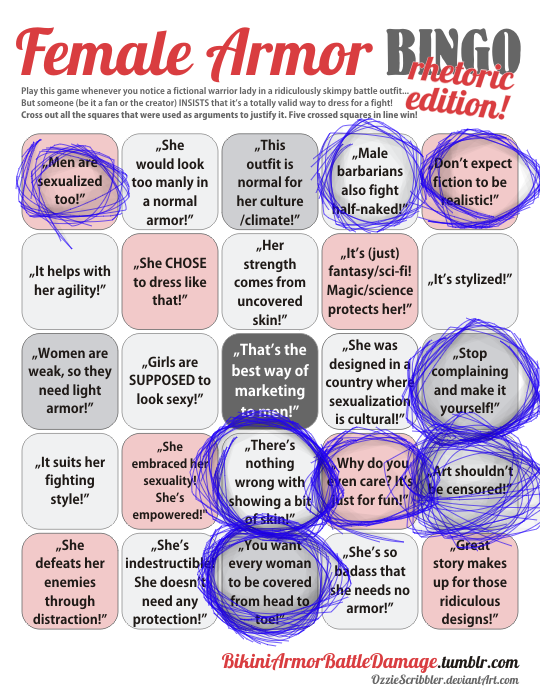
Wow, he scored ridiculously high even without a custom card!
TL, DR: There goes any benefit of the doubt we could have had for this artist when it comes to deciding how “creative” the final designs get.
Big thanks to Liliana for submitting!
~Ozzie
Curiously he claims he loves feedback… I guess he means feedback that doesn’t challenge any of his assumptions, privileges, etc.
What I really love about his strange notion though is – can you imagine if it was extended into any other field?
“I am a chef, and the restaurant owner told me we’re not going to serve pale veal any more due to animal cruelty concerns – I implore you all not to self censor your dinner tables!”
“I am a banker and we have been told not to use pressure tactics to get customers to sign up for credit cards – Do not allow yourself to be censored when manipulating others!”
“I am a janitor and we have been told not to use this chemical that upsets some people’s skin – Do not allow others to tell you what you what cleaning chemicals you should use at home!”
My personal favorite snippets:
- “Also blackmails in the form of ”change your game art or we won’t publish a single word about you.” is a common behavior found among those.“ – Given that the games industry and games journalism market is ridiculously competitive, I think this would be the smallest challenge publicity wise. After all, it’s a game that uses the core mechanics of what was the “new hotness” fifteen years ago. Not exactly ground breaking or that special given that the Indy games marketplace is flooded with nostalgia.
- “If by all means the opposition feels change is needed, let it NOT be by oppressing others art but by just offering an alternative for those who wish an alternative.“ – Apparently he believes there are game making elves (similar to cobbling elves, but different) out there who will just create quality games with equal armor without anyone in the industry having to do the work… strange stance for a man who should be aware there are no game making elves. Games require teams of professionals, budgets, investors, distributors, etc
- “This journal entry is all about judgmental journalism, offended-by-design opinionators and the fearsome white knights that the first two bring in its wake.” – I’m not sure I’ve ever met anyone who’s offended by the concept of design… it strikes me as a terrible life. I’m also pretty sure since most games journalism is reviews – that being judgmental is kind of a prerequisite for the job.
All of this vitriol because his boss asked him to… do his job.
– wincenworks


